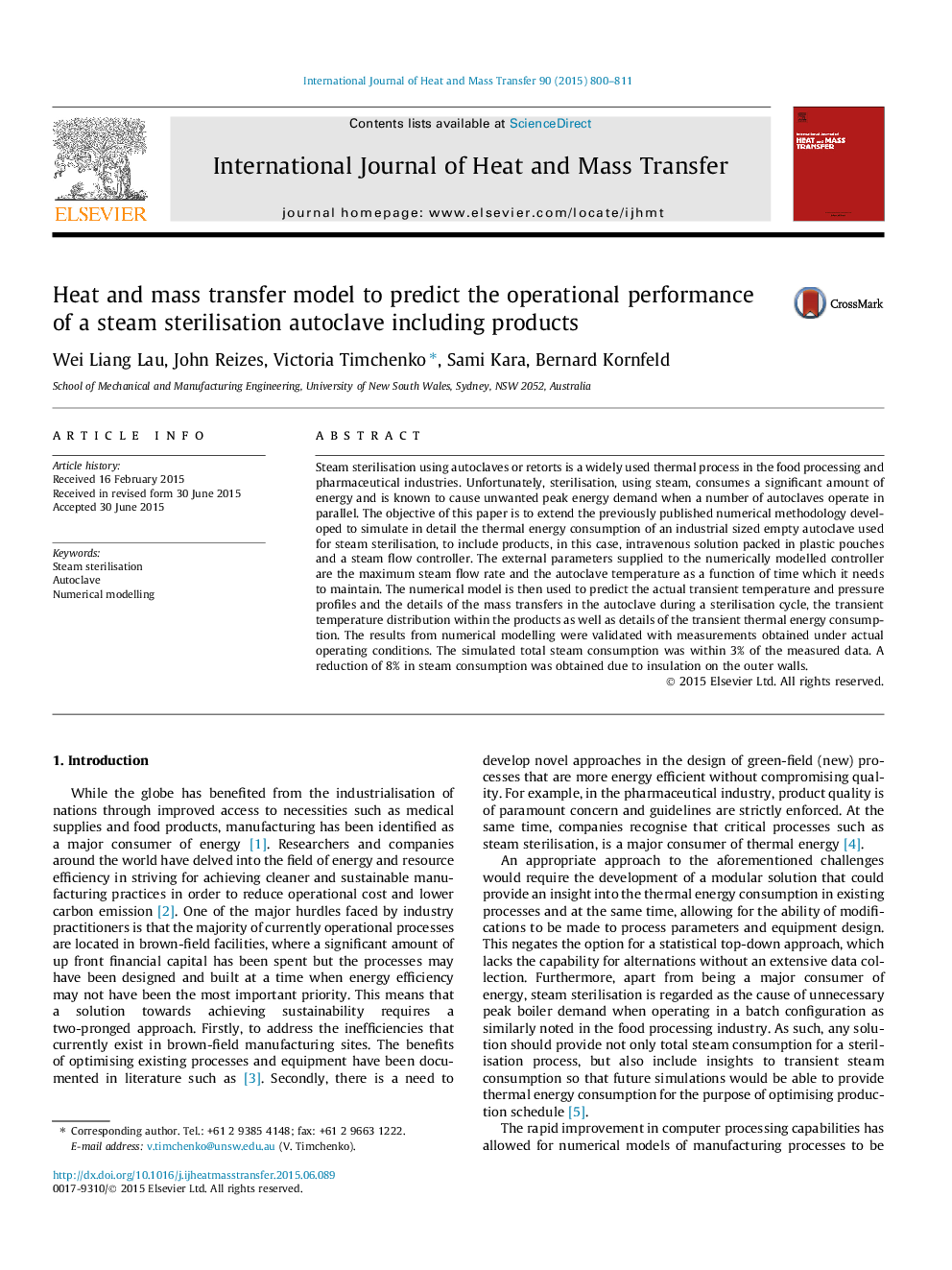| کد مقاله | کد نشریه | سال انتشار | مقاله انگلیسی | نسخه تمام متن |
|---|---|---|---|---|
| 7056541 | 1458052 | 2015 | 12 صفحه PDF | دانلود رایگان |
عنوان انگلیسی مقاله ISI
Heat and mass transfer model to predict the operational performance of a steam sterilisation autoclave including products
ترجمه فارسی عنوان
مدل انتقال حرارت و جرم برای پیش بینی عملکرد عملیاتی یک اتوکلاو استریلیزاسیون بخار از جمله محصولات
دانلود مقاله + سفارش ترجمه
دانلود مقاله ISI انگلیسی
رایگان برای ایرانیان
کلمات کلیدی
عقیم سازی بخار، اتوکلاو، مدل سازی عددی،
ترجمه چکیده
استریلیزاسیون بخار با استفاده از اتوکلاوها یا رتورها یک فرآیند حرارتی به طور گسترده ای در صنایع فرآوری مواد غذایی و داروسازی است. متاسفانه، استریلیزاسیون با استفاده از بخار مقدار قابل توجهی از انرژی مصرف می کند و به علت افزایش تقاضای پیک های ناخواسته، زمانی که تعدادی از اتوکلاو ها موازی عمل می کنند، شناخته شده است. هدف از این مقاله گسترش روش پیشین منتشر شده عددی است که برای شبیه سازی دقیق مصرف انرژی حرارتی اتوکلاو خالی صنعتی استفاده شده برای استرلیزه بخار به کار رفته و شامل محصولات، در این مورد، راه حل داخل وریدی بسته بندی شده در کیسه های پلاستیکی و بخار کنترل جریان. پارامترهای خارجی که به کنترل کننده عددی مدل شده ارائه می شوند، حداکثر سرعت بخار و دمای اتوکلو به عنوان تابعی از زمان است که نیاز به نگهداری دارد. سپس مدل عددی برای پیش بینی پروفیل های دما و فشار گذار واقعی و جزئیات انتقال جرم در اتوکلاو در طی یک دوره استریلیزاسیون، توزیع دما گذرا در محصولات و نیز جزئیات مصرف انرژی حرارتی گذرا مورد استفاده قرار می گیرد. نتایج حاصل از مدل سازی عددی با اندازه گیری های به دست آمده در شرایط عملیاتی معتبر مورد تایید قرار گرفت. مصرف همزمان بخار در مجموع 3٪ از داده های اندازه گیری شده بود. کاهش بخار 8٪ به دلیل عایق بندی دیوارهای خارجی بدست آمد.
موضوعات مرتبط
مهندسی و علوم پایه
مهندسی شیمی
جریان سیال و فرایندهای انتقال
چکیده انگلیسی
Steam sterilisation using autoclaves or retorts is a widely used thermal process in the food processing and pharmaceutical industries. Unfortunately, sterilisation, using steam, consumes a significant amount of energy and is known to cause unwanted peak energy demand when a number of autoclaves operate in parallel. The objective of this paper is to extend the previously published numerical methodology developed to simulate in detail the thermal energy consumption of an industrial sized empty autoclave used for steam sterilisation, to include products, in this case, intravenous solution packed in plastic pouches and a steam flow controller. The external parameters supplied to the numerically modelled controller are the maximum steam flow rate and the autoclave temperature as a function of time which it needs to maintain. The numerical model is then used to predict the actual transient temperature and pressure profiles and the details of the mass transfers in the autoclave during a sterilisation cycle, the transient temperature distribution within the products as well as details of the transient thermal energy consumption. The results from numerical modelling were validated with measurements obtained under actual operating conditions. The simulated total steam consumption was within 3% of the measured data. A reduction of 8% in steam consumption was obtained due to insulation on the outer walls.
ناشر
Database: Elsevier - ScienceDirect (ساینس دایرکت)
Journal: International Journal of Heat and Mass Transfer - Volume 90, November 2015, Pages 800-811
Journal: International Journal of Heat and Mass Transfer - Volume 90, November 2015, Pages 800-811
نویسندگان
Wei Liang Lau, John Reizes, Victoria Timchenko, Sami Kara, Bernard Kornfeld,
